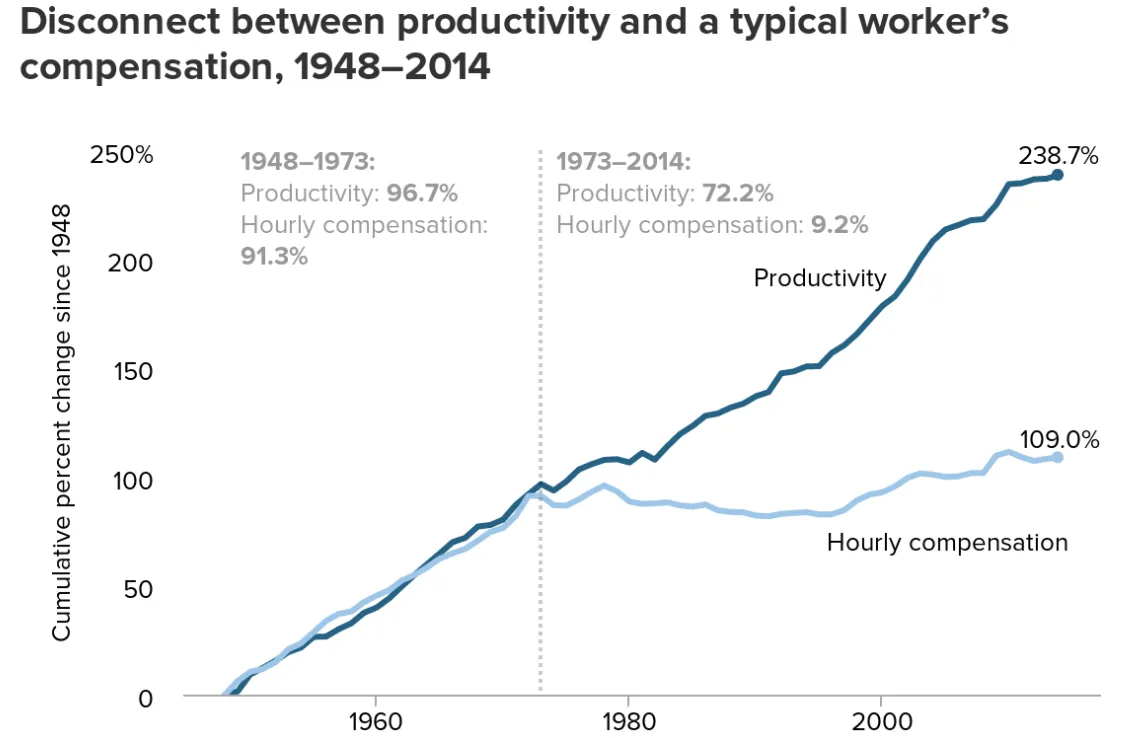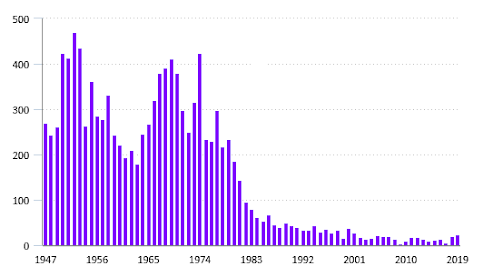The Teamsters: A Union Without a Party
Biden and Trump are currently tied at 47% percent support among union members in swing states. The Teamsters, one of the most important labor unions in the United States with 1.3 million members, have as of this publication refrained from endorsing a candidate in the 2024 presidential race. General President of the International Brotherhood of Teamsters Sean O’Brien, no doubt a man with substantial political skill and clear strategies in mind, broke precedent by giving a keynote at the Republican National Convention. Many are left wondering if these signals mark a shift in the political landscape for a labor union which has been aligned with the Democratic Party for over 30 years. There is no specific evidence suggesting that O'Brien’s goal is to motivate rank-and-file members to vote against their interests for the benefit of corporate owners. The lack of endorsement from the union he leads underscores a broader question: what is the strategy and will it benefit American workers?

Getting Out of the Bubble
Biden’s administration has enacted significant pro-labor actions, such as appointing union-friendly officials to the National Labor Relations Board and supporting pension funds in distress. Despite Biden’s pro-union stance and policies aimed at bolstering labor rights, O’Brien likely recognizes that unconditional support of the Democratic party puts his organization at odds with the views of many rank-and-file Teamsters. There is often a justified skepticism among members about whether union leadership is too closely aligned with certain political groups, potentially at the expense of the membership's interests. Working class people might not know exactly why they seem to be struggling more than prior generations, or struggling more in 2024 than in 2019, but they know that they are. They pay their union dues so leaders can find out these reasons and help them take the steps needed to improve their circumstances. When this is not being done they rightly point their fingers at those who are paid to represent their interest.

Former President Trump has capitalized on this feeling to target union leadership himself, particularly criticizing Biden's push for electric vehicles during the UAW strike, driving a wedge between union officers and the rank-and-file members. Republican leaders such as Trump have portrayed themselves as outsiders fighting against the "elite," including political, corporate, and union leadership. The message speaks to workers who feel disenfranchised or overlooked by the political establishment, including some parts of the Democratic Party that they perceive as having taken their support for granted. When Trump says “auto workers are getting totally ripped off by Crooked Joe Biden and also their horrendous leadership… your union heads know it, but the union bosses don’t want to do anything about it because they are not leaders,” whether this is true or not, union members listen.
Annual Work Stoppages Involving 1000 or More Workers, 1947-2019

Republican messaging often emphasizes economic growth, lower taxes, and deregulation, aspects that connect with workers who feel that current economic policies might not favor their immediate financial circumstances. For instance, Republican emphasis on job creation in industries like manufacturing, coal, and oil appeals to workers in these sectors who may fear job loss due to environmental regulations supported by Democrats. Certain union members may also feel that conservative values on social issues, which Republicans often champion, are more aligned with their personal beliefs than the messages that union leaders are communicating. O’Brien’s speech, although it did not address all labor issues such as right-to-work, was decidedly pro-labor, discussing points such as the power Amazon has over its workforce and our nation. Nielsen estimates 18.13 million viewers tuned in to the first night of the Republican National Convention. Many of these people may not otherwise hear from a forceful union leader discussing pro-labor issues. It’s possible that O’Brien, by giving a speech at the RNC, simply calculated that the risk of his speech being seen as legitimizing the anti-labor wing of the Republican Party was worth getting pro-labor points in front of Republican workers who, each in their own information bubble, may not otherwise hear his message.
Asking for More
“There’s no dispute that President Biden has been great for unions, especially the Teamsters union. But like everything else we do, there’s always room for improvement. There’s always a threat to organized labor, so we want to be proactive and make certain every candidate — not just President Biden — understands how important our issues are.” - Sean O’Brien, March 2024
Showing that the Teamsters are advocates for the rights of workers and not just one party might encourage more responsive policy proposals from both sides. It was hard to ignore a few individual Republicans clapping for certain pro-labor points during the RNC keynote. By emphasizing a non-partisan evaluation of candidates based on their specific commitments to labor rights and economic policies rather than traditional party alignments, labor leaders may be able to achieve greater gains in Republican led areas among those candidates who have flexibility to support labor values.

This also raises a significant point of discussion about the evolving relationship between organized labor and the Democratic party candidates it traditionally endorses. Is the Democratic Party doing all it can for the working class, or is the populist wing of the Republican Party becoming a viable alternative to seek improved labor conditions despite its traditionally pro-shareholder stance? This development could signal a crucial transformation in how political parties align and interact with organized labor, influencing future elections and policy directions. This approach may encourage both parties to more vigorously address the needs and concerns of working-class Americans, ensuring that their policies align more closely with the interests of those they aim to represent. If this is the intention, and O’Brien can show evidence that his tactic works to extract greater pro-labor policies from both parties, we may see other unions using this tactic in the future.
A Deeper Strategic Shift
Finally, the Teamsters' current stance of withholding a quick endorsement may not just be a tactical decision for the 2024 election, but potentially a recalibration of the political dynamics between organized labor and the major American political parties. Working class values are not static. The idea that all who sell their labor must stand in solidarity, regardless of background, may be in the past for some workers, replaced by solidarity based on what background a worker was born into. Leaders have some ability to choose which values their organization will embody, and unions are currently facing a deficit of past leadership to communicate a key labor idea; divisions among those who sell their labor make it difficult to unite for better conditions, and this unity is always under attack. It is possible that union leadership, whether through a decision to lean into the divisions that some rank-and-file members may currently feel or a belief that following strongman politicians will best serve union interests, will make allowances for the divisive rhetoric that some politicians use to connect themselves to working voters.

Leaders may be thinking that the basic elements of labor-shareholder relationships have somehow changed. It may be that union leaders have come to believe addressing the leverage corporations have to influence labor outcomes, sometimes in the face of charismatic opposition, is not as important to their modern agenda as supporting corporate interests which are popular with their members. It is possible they will ask their membership to have faith that the reasons working people have challenges building wealth can be addressed by Republican policies which have historically put the interests of shareholders ahead of labor.
If this is the case, we may need to acknowledge a more fundamental shift, and ask how far this change will go before workers find their equilibrium. Samel Gompers, founder of the A.F. of L, a predecessor the AFL-CIO, took this path, leaning into anti-Asian sentiments in his time through bulletins such as Meat vs. Rice. American Manhood against Asiatic Coolieism. Which shall survive? and by directing his union to attach white stickers to cigars to discourage consumers from purchasing tobacco rolled by Chinese laborers.
1901 AF of L Anti-Immigrant Literature

Gompers bragged that the union he led, "was the first national organization which demanded the exclusion of coolies from the United States." 80 years later, Teamster’s president Jackie Presser formed a close relationship with Ronald Reagan, leading the Teamsters to endorse Reagan’s candidacy, and paving the way for Reagan’s administration to later take such anti-union actions as breaking PATCO and making NLRB appointments that helped corporations cut union employee wages and benefits. Will today’s union leaders put their voice behind equivalent modern rhetoric, legitimizing notions such as the Republican idea that immigrant workers are a different class than native-born workers, or that supporting shareholder-oriented candidates will benefit labor outcomes? Only time will tell.
The Future of Labor Politics
As the political dynamics continue to shift, the Teamsters' current stance might signify many different paths. Both leaders and rank-and-file members are considering the future of labor politics, the implications of partisan realignments, and the strategies that best serve the interests of workers. Union groups face questions of whether labor should serve as steadfast allies to a particular party or as independent advocates for workers' rights, flexibly navigating the political spectrum to champion the interests of their members. Some may be wondering what the interests of their members really are, and whether the labor values of the past reflect the current goals of their membership. The outcome of this recalibration could have profound effects and unexpected outcomes. The Teamsters have made a choice to test the waters. The impacts of this may influence not only the next election cycle but also the long-term relationship between American workers and the politicians seeking their support.
If you found this topic interesting, please let me know by clicking here to support my writing.
